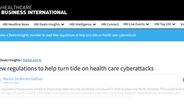- Lloyd Price
Bridges and Tunnels: Future High Value Assets in Healthcare Technology

Exec Summary:
The bridges and tunnels in healthcare technology are the infrastructure and systems that enable the efficient and reliable delivery of healthcare services. This includes:
Communication networks: Communication networks such as the internet and cellular networks enable healthcare providers to communicate with each other and with their patients. This is essential for providing telemedicine services, remote patient monitoring, and other healthcare services that rely on data sharing.
Electronic health records (EHRs): EHRs allow healthcare providers to store and share patient medical records electronically. This improves the coordination of care and makes it easier for patients to access their medical records.
Health information exchanges (HIEs): HIEs connect different healthcare organizations, such as hospitals, clinics, and pharmacies, so that they can share patient medical records electronically. This improves the coordination of care and makes it easier for patients to access their medical records.
Clinical decision support systems (CDSSs): CDSSs provide healthcare providers with real-time clinical information and decision support at the point of care. This helps healthcare providers to make better decisions about patient care.
In addition to the above, the following technologies can also be considered as bridges and tunnels in healthcare technology:
Wearable devices: Wearable devices such as smartwatches and fitness trackers can collect data on patients' health and activity levels. This data can be used to monitor patients' health remotely and to provide them with personalized health recommendations.
Remote patient monitoring (RPM): RPM technologies allow healthcare providers to monitor patients' health remotely. This can be done using wearable devices, other medical devices, or mobile apps. RPM can help healthcare providers to identify and treat potential health problems early on.
Telemedicine: Telemedicine is the remote delivery of healthcare services. Telemedicine technologies allow healthcare providers to connect with patients and provide them with care without having to meet in person. This is especially important for patients in rural or remote areas, or for patients who have difficulty traveling.
These technologies are essential for the delivery of modern healthcare. They enable healthcare providers to communicate with each other and with their patients more effectively, to coordinate care more efficiently, and to provide better quality care.
As healthcare technology continues to evolve, new bridges and tunnels will emerge to enable the delivery of new and innovative healthcare services.
Corporate Development for Healthcare Technology companies in EMEA
Healthcare Technology Thought Leadership from Nelson Advisors – Market Insights, Analysis & Predictions. Visit https://www.healthcare.digital
HealthTech Corporate Development - Buy Side, Sell Side, Growth & Strategy services for Founders, Owners and Investors. Email lloyd@nelsonadvisors.co.uk
HealthTech M&A Newsletter from Nelson Advisors - HealthTech, Health IT, Digital Health Insights and Analysis. Subscribe Today! https://lnkd.in/e5hTp_xb
HealthTech Corporate Development and M&A - Buy Side, Sell Side, Growth & Strategy services for companies in Europe, Middle East and Africa. Visit www.nelsonadvisors.co.uk

The Bridges
A bridge is a technology that connects different parts of a technological system or enables communication and collaboration between different technologies. Bridges can be used to improve the efficiency, reliability, and security of a technological system, or to enable new and innovative applications.
Some examples of bridges in technology include:
Network bridges: Network bridges connect different network segments, such as Ethernet segments or wireless networks. This allows devices on different networks to communicate with each other.
API gateways: API gateways provide a single point of access to a set of back-end APIs. This makes it easier for developers to access and use the APIs, and it can also improve the security and reliability of the APIs.
Messaging systems: Messaging systems allow applications to communicate with each other by exchanging messages. This can be used to implement a variety of different patterns, such as microservices architectures and event-driven architectures.
Data integration platforms: Data integration platforms allow data to be shared and exchanged between different data sources. This can be used to create a unified view of data from different systems, or to enable new applications that require data from multiple sources.
Cloud computing platforms: Cloud computing platforms provide a set of services that can be used to build and deploy applications. Cloud computing platforms can be used to bridge different technologies, such as on-premises infrastructure and cloud-based services.
Bridges in technology play an important role in the development and deployment of new and innovative applications. They enable different technologies to work together seamlessly and efficiently, and they can also help to improve the security and reliability of technological systems.
Here are some specific examples of how bridges in technology are being used to improve the way we live and work:
Messaging systems are used to enable real-time communication between applications. For example, messaging systems are used to power instant messaging apps, social media platforms, and e-commerce websites.
Data integration platforms are used to combine data from different sources to create a unified view of data. This can be used to improve customer service, fraud detection, and other business processes.
Cloud computing platforms are used to build and deploy a wide range of applications, from simple websites to complex enterprise applications. Cloud computing platforms make it easier and more cost-effective to develop and deploy new applications.
Bridges in technology are essential for the modern world. They enable us to connect with each other, access information, and use services in new and innovative ways. As technology continues to evolve, we can expect to see even more innovative and transformative applications of bridges in technology.

The Tunnels
A tunnel in technology is a way to encapsulate data or traffic within another layer of data or traffic. This can be done for a variety of reasons, such as to encrypt data, to improve performance, or to hide the contents of the data from intermediate nodes.
Some examples of tunnels in technology include:
VPN tunnels: VPN tunnels encrypt data and send it over a public network, such as the internet. This allows users to securely access resources on a private network, such as a corporate network.
SSH tunnels: SSH tunnels provide a secure connection between two hosts. This can be used to forward traffic between the hosts, or to provide remote access to a host.
HTTP tunnels: HTTP tunnels encapsulate HTTP traffic within another layer of HTTP traffic. This can be used to bypass web filters or to hide the contents of the traffic from intermediate nodes.
Web sockets: Web sockets provide a full-duplex communication channel over a single TCP connection. This can be used to implement real-time communication between web applications and servers.
API tunnels: API tunnels allow applications to communicate with each other through a secure and reliable channel. This can be used to implement micro-services architectures or to integrate applications with third-party services.
Tunnels in technology can be used to improve the security, performance, and reliability of communication networks and applications. They can also be used to hide the contents of data from intermediate nodes, which can be useful for privacy and security purposes.
Here are some specific examples of how tunnels in technology are being used to improve our lives:
VPN tunnels are used to allow employees to securely access resources on a corporate network from home or while traveling.
SSH tunnels are used to provide remote access to servers in data centers.
HTTP tunnels are used to bypass web filters in countries with internet censorship.
Web sockets are used to implement real-time communication in web applications, such as chat apps and multiplayer games.
API tunnels are used to integrate applications with third-party services, such as payment processors and social media platforms.
Tunnels in technology are an essential part of the modern internet. They enable us to communicate securely and reliably, and they can also be used to implement new and innovative applications. As technology continues to evolve, we can expect to see even more innovative and transformative applications of tunnels in technology.

Final Thoughts:
The bridges and tunnels of the future in healthcare technology will be the infrastructure and systems that enable the efficient and reliable delivery of personalized, preventive, and precision healthcare. This is likely to include the following:
Next-generation communication networks: Next-generation communication networks such as 5G and 6G will enable the real-time transmission of large amounts of data, which is essential for many emerging healthcare technologies, such as remote surgery and augmented reality.
Quantum computing: Quantum computing has the potential to revolutionize healthcare by enabling the development of new drugs and treatments, and by improving the accuracy of medical diagnosis.
Artificial intelligence (AI): AI is already being used in a variety of ways in healthcare, such as developing new drugs and treatments, and assisting with medical diagnosis. In the future, AI is likely to play an even greater role in healthcare, and next-generation communication networks and quantum computing will be essential for enabling the development and deployment of AI-powered healthcare solutions.
The Internet of Things (IoT): The IoT is a network of physical objects that are embedded with sensors and software, enabling them to collect and exchange data. In healthcare, the IoT can be used to collect data on patients' health and activity levels, which can be used to improve preventive care and remote patient monitoring.
In addition to the above, the following technologies can also be considered as bridges and tunnels of the future in healthcare technology:
Digital twins: Digital twins are virtual replicas of real-world objects, systems, and processes. In healthcare, digital twins can be used to create virtual models of patients' bodies and organs. This can be used to improve medical diagnosis and treatment planning.
Virtual reality (VR) and augmented reality (AR): VR and AR technologies can be used to create immersive and interactive experiences for healthcare professionals and patients. For example, VR could be used to train surgeons on new procedures, or AR could be used to help patients visualize their medical condition.
These technologies are still in their early stages of development, but they have the potential to revolutionize the way healthcare is delivered. The bridges and tunnels of the future in healthcare technology will enable the delivery of personalised, preventive, and precision healthcare to all.
Here are some specific examples of how the bridges and tunnels of the future in healthcare technology could be used:
A patient with a chronic condition could wear a wearable device that collects data on their health and activity levels. This data could be transmitted to a cloud-based platform using a next-generation communication network. An AI-powered algorithm could then analyze the data and identify potential health problems early on. The algorithm could then send alerts to the patient's healthcare provider, who could then intervene to prevent the problem from becoming more serious.
A surgeon could use a VR headset to train on a new surgical procedure. The VR headset would create a realistic simulation of the surgical procedure, allowing the surgeon to practice without putting any patients at risk.
A patient with a complex medical condition could have a digital twin created of their body. This digital twin could then be used by healthcare professionals to plan and simulate treatment options.
These are just a few examples of how the bridges and tunnels of the future in healthcare technology could be used. As these technologies continue to develop, we can expect to see even more innovative and transformative applications in the years to come.
Corporate Development for Healthcare Technology companies in EMEA
Healthcare Technology Thought Leadership from Nelson Advisors – Market Insights, Analysis & Predictions. Visit https://www.healthcare.digital
HealthTech Corporate Development - Buy Side, Sell Side, Growth & Strategy services for Founders, Owners and Investors. Email lloyd@nelsonadvisors.co.uk
HealthTech M&A Newsletter from Nelson Advisors - HealthTech, Health IT, Digital Health Insights and Analysis. Subscribe Today! https://lnkd.in/e5hTp_xb
HealthTech Corporate Development and M&A - Buy Side, Sell Side, Growth & Strategy services for companies in Europe, Middle East and Africa. Visit www.nelsonadvisors.co.uk








